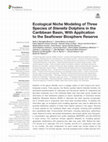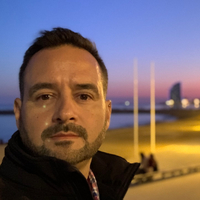Papers by Jaime Bolaños Jiménez

Journal of Applied Ecology, 2023
Each year, whale sharks (Rhincodon typus) aggregate in the northern Gulf of California at Bahia d... more Each year, whale sharks (Rhincodon typus) aggregate in the northern Gulf of California at Bahia de los Angeles, a small coastal village that recently developed whale shark swimming as economic activity during the summer and autumn. Since the number of animals using the bay fluctuates annually, we aimed to predict it 1 month before each whale shark season. We based our modelling approach on the hypothesis that interannual warming conditions would spatially restrict whale shark habitats, triggering larger aggregations in areas that remain productive.
We photo-identified whale sharks while surface feeding in Bahia de los Angeles during a 13-year period, which allowed us to estimate a local abundance index per year through mark–recapture techniques. Then, we fitted these abundances as a function of several competing model structures, based on means of sea surface temperature and chlorophyll-a, as well as their interannual anomalies from the linear trend, during spring, within the best-known range of the species in the northern Gulf of California.
The results of the ecological model showed that whale sharks visit Bahia de los Angeles in larger numbers during extreme warming conditions, with relatively high surface chlorophyll-a concentrations, which was especially evident during the 2014–2016 northeast Pacific Marine Heatwave and El Niño. Presumably, the overall reduction in surface productivity associated with these events forced whale sharks to restrict their summer–autumn habitat to productivity hotspots, including Bahia de los Angeles.
Our model allowed us to predict the number of animals visiting the site before each season starts, which has crucial proactive management implications, such as allowing authorities to regulate the ecotourism effort dynamically to reduce the probability of ship strikes and/or excessive stress to the animals. We propose an abundance baseline from the prediction for neutral interannual conditions.
Synthesis and applications. We recommend local authorities apply the model described in this study during the late spring of each year to obtain predictions of the upcoming whale shark abundance and establish the maximum ecotourism effort allowed accordingly.
Latin American Journal of Aquatic Mammals, 2009
The assessment of the status of the small cetaceans of
the Caribbean Sea was set as a priority b... more The assessment of the status of the small cetaceans of
the Caribbean Sea was set as a priority by the Scientific
Committee of the International Whaling Commission
(IWC) during its 57th Annual Meeting held in Ulsan,
Korea, in 2005 (IWC, 2006). In the present note we contribute to the knowledge on the
occurrence of killer whales in Venezuelan waters on the
basis of opportunistic sightings.
Latin American Journal of Aquatic Mammals, Mar 29, 2022

Latin American Journal of Aquatic Mammals, Mar 29, 2022
To test this hypothesis a photo-ID survey in 2018 and 2019 was conducted, resulting in 54,298 pho... more To test this hypothesis a photo-ID survey in 2018 and 2019 was conducted, resulting in 54,298 photographs. With no matches of individuals between islands, our findings do not support regular exchange of PSD individuals between Martinique and Guadeloupe. However, given previous re-sighting data, it is possible that movement of individuals between islands exists but at lower frequencies than expected, which can only be detected through long-term surveys. Additionally, populations from both islands showed relatively high site fidelity. We found that in Guadeloupe the PSD population is homogeneously distributed along the coast. In contrast, in Martinique the PSD population was composed of two resident groups concentrated in one area. Moreover, 70 new individuals were identified in Guadeloupe and 54 in Martinique while POPAN modelling estimated the number of marked individuals in the study area during 2018 and 2019 at 89 in Guadeloupe and 90 in Martinique. This research provides the first insights on the residency and movement patterns of S. attenuata in the Agoa Sanctuary and can inform future efforts in management and conservation. in number and size as it gets older (Jefferson et al.

Latin American Journal of Aquatic Mammals, 2022
The Guiana dolphin (Sotalia guianensis) occurs in warm and shallow waters of the Atlantic Ocean a... more The Guiana dolphin (Sotalia guianensis) occurs in warm and shallow waters of the Atlantic Ocean and the Caribbean Sea, from southern Brazil to Honduras, including estuarine and freshwater habitats such as Maracaibo Lake (Venezuela), and the Orinoco River. In 2018, the Guiana dolphin was reclassified from Data Deficient to Near Threatened on the global IUCN Red List. Nevertheless, the conservation status identified by national and regional Red Lists is even more alarming. In French Guiana, for example, the species is classified as Endangered based on strong pressures such as bycatch. In this region, the Guiana dolphin inhabits river mouths and coastal waters where most anthropogenic activities occur. Better knowledge of the biology and ecology is needed in French Guiana to help inform effective conservation actions. Here, we present ongoing studies to map the distribution of Guiana dolphins along the French Guiana coast and estimate abundance in a hotspot area. Aerial survey campaign...

La costa del estado Aragua es hábitat de poblaciones de delfines y ballenas. En la región se encu... more La costa del estado Aragua es hábitat de poblaciones de delfines y ballenas. En la región se encuentran el delfín manchado del Atlántico (Stenella frontalis) y el guamachín o “delfín nariz de botella” (Tursiops truncatus) y la ballena arenquera (Balaenoptera edeni). La tasa de encuentro con grupos de delfines en su medio natural es cercana al 70%. Desde el año 2001 -con base en estos resultados- Sea Vida ha estado promoviendo el “Ecoturismo orientado hacia mamíferos marinos” (EOMM) como una alternativa de uso sustentable de la diversidad biológica marina. Uno de los mayores retos hasta el momento, ha sido lograr la incorporación activa de la comunidad local. Para lograrlo, se diseñó un proyecto de investigación-acción, dirigido a la participación de docentes y alumnos de instituciones educativas locales. Las actividades de campo se realizaron entre abril-junio de 2005. En una primera fase, se presentaron videos y charlas acerca de los delfines y ballenas de la región. En la segunda ...
Marine Mammal Science, 2021

Frontiers in Marine Science
The presence of transient and temporary individuals in capture-mark-recapture studies may violate... more The presence of transient and temporary individuals in capture-mark-recapture studies may violate the assumption on equal catchability, and thus yield biased estimates. We investigated the effects of residency patterns on population parameters of bottlenose dolphins inhabiting the coastal waters off the Alvarado Lagoon System (ALS), Veracruz, Mexico. We hypothesized that this population is open but there exists a “core community” that behaves as a closed population. Between 2006 and 2010, we conducted 75 photo-identification surveys and recorded 263 dolphin group encounters, in which 231 dolphins were identified. Individuals present during only one season, classified as transients (n = 85), were excluded from the study, and a standardized residency index (IH4) was computed for each dolphin that remained in the sample (n = 146). We used the K-means clustering method to split the sample into groups based on individual (seasonal, annual) IH4 values. These clusters were named as regular...
Sotalia dolphins inhabit the Amazon and Orinoco River basins and the Caribbean and Atlantic coast... more Sotalia dolphins inhabit the Amazon and Orinoco River basins and the Caribbean and Atlantic coasts in Central and South America (Flores and da Silva, 2009). The
Latin American Journal of Aquatic Mammals, 2010

Frontiers in Marine Science
The presence of transient and temporary individuals in capture-mark-recapture studies may violate... more The presence of transient and temporary individuals in capture-mark-recapture studies may violate the assumption on equal catchability, and thus yield biased estimates. We investigated the effects of residency patterns on population parameters of bottlenose dolphins inhabiting the coastal waters off the Alvarado Lagoon System (ALS), Veracruz, Mexico. We hypothesized that this population is open but there exists a “core community” that behaves as a closed population. Between 2006 and 2010, we conducted 75 photo-identification surveys and recorded 263 dolphin group encounters, in which 231 dolphins were identified. Individuals present during only one season, classified as transients (n = 85), were excluded from the study, and a standardized residency index (IH4) was computed for each dolphin that remained in the sample (n = 146). We used the K-means clustering method to split the sample into groups based on individual (seasonal, annual) IH4 values. These clusters were named as regular...
Latin American Journal of Aquatic Mammals, 2010
Building a network of freshwater protected areas (FWPAs) critical to river dolphins conservation. In
Latin American Journal of Aquatic Mammals
Cuvier's beaked whale is the most cosmopolitan of the beaked whales and is found in all ocean... more Cuvier's beaked whale is the most cosmopolitan of the beaked whales and is found in all oceans except in the high polar waters. This species is known from over 1800 strandings. In the Caribbean strandings are rare, and we present a first record from Antigua and Barbuda.

Frontiers in Marine Science
Barragán-Barrera et al. Potential Distribution Stenella in Caribbean test values higher than 0.8,... more Barragán-Barrera et al. Potential Distribution Stenella in Caribbean test values higher than 0.8, indicating satisfactory model performance. The resulting potential distribution maps suggested that areas closest to continental shorelines of the Caribbean Basin and surrounding islands had the highest environmental suitability for all species (>70%). All models reported high environmental suitability for S. attenuata and S. longirostris in the SFBR, mainly in the southernmost part surrounding San Andrés and Providence Archipelago. Assessment of niche overlap from the predictions of species distributions using the similarity statistic and pairwise map overlap indicated that S. frontalis and S. longirostris had niches slightly more similar in comparison to S. attenuata. As this was a first effort to fill a gap in our understanding of the distribution of species in the genus Stenella in the Caribbean Basin, further studies are necessary using both niche modeling and biological/ecological approaches.











Uploads
Papers by Jaime Bolaños Jiménez
We photo-identified whale sharks while surface feeding in Bahia de los Angeles during a 13-year period, which allowed us to estimate a local abundance index per year through mark–recapture techniques. Then, we fitted these abundances as a function of several competing model structures, based on means of sea surface temperature and chlorophyll-a, as well as their interannual anomalies from the linear trend, during spring, within the best-known range of the species in the northern Gulf of California.
The results of the ecological model showed that whale sharks visit Bahia de los Angeles in larger numbers during extreme warming conditions, with relatively high surface chlorophyll-a concentrations, which was especially evident during the 2014–2016 northeast Pacific Marine Heatwave and El Niño. Presumably, the overall reduction in surface productivity associated with these events forced whale sharks to restrict their summer–autumn habitat to productivity hotspots, including Bahia de los Angeles.
Our model allowed us to predict the number of animals visiting the site before each season starts, which has crucial proactive management implications, such as allowing authorities to regulate the ecotourism effort dynamically to reduce the probability of ship strikes and/or excessive stress to the animals. We propose an abundance baseline from the prediction for neutral interannual conditions.
Synthesis and applications. We recommend local authorities apply the model described in this study during the late spring of each year to obtain predictions of the upcoming whale shark abundance and establish the maximum ecotourism effort allowed accordingly.
the Caribbean Sea was set as a priority by the Scientific
Committee of the International Whaling Commission
(IWC) during its 57th Annual Meeting held in Ulsan,
Korea, in 2005 (IWC, 2006). In the present note we contribute to the knowledge on the
occurrence of killer whales in Venezuelan waters on the
basis of opportunistic sightings.
We photo-identified whale sharks while surface feeding in Bahia de los Angeles during a 13-year period, which allowed us to estimate a local abundance index per year through mark–recapture techniques. Then, we fitted these abundances as a function of several competing model structures, based on means of sea surface temperature and chlorophyll-a, as well as their interannual anomalies from the linear trend, during spring, within the best-known range of the species in the northern Gulf of California.
The results of the ecological model showed that whale sharks visit Bahia de los Angeles in larger numbers during extreme warming conditions, with relatively high surface chlorophyll-a concentrations, which was especially evident during the 2014–2016 northeast Pacific Marine Heatwave and El Niño. Presumably, the overall reduction in surface productivity associated with these events forced whale sharks to restrict their summer–autumn habitat to productivity hotspots, including Bahia de los Angeles.
Our model allowed us to predict the number of animals visiting the site before each season starts, which has crucial proactive management implications, such as allowing authorities to regulate the ecotourism effort dynamically to reduce the probability of ship strikes and/or excessive stress to the animals. We propose an abundance baseline from the prediction for neutral interannual conditions.
Synthesis and applications. We recommend local authorities apply the model described in this study during the late spring of each year to obtain predictions of the upcoming whale shark abundance and establish the maximum ecotourism effort allowed accordingly.
the Caribbean Sea was set as a priority by the Scientific
Committee of the International Whaling Commission
(IWC) during its 57th Annual Meeting held in Ulsan,
Korea, in 2005 (IWC, 2006). In the present note we contribute to the knowledge on the
occurrence of killer whales in Venezuelan waters on the
basis of opportunistic sightings.